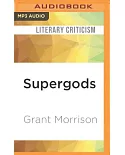"Over the past forty years, American film has entered into a formal interaction with the comic book. Such comic book adaptations as Sin City, 300, and Scott Pilgrim vs. the World have adopted
components of their source materials’ visual style. The screenhas been fractured into panels, the photographic has given way to the graphic, and the steady rhythm of cinematic time has evolved
into a far more malleable element. In other words, films have begun to look like comics. Yet, this interplay also occurs inthe other direction. In order to retain cultural relevancy, comic
books have begun to look like films. Frank Miller’s original Sin City comics are indebted to film noir while Stephen King’s The Dark Tower series could be a Sergio Leone spaghetti western
translated onto paper. Film and comic books continuously lean on one another to reimagine their formal attributes and stylistic possibilities. In Panel to the Screen, Drew Morton examines this
dialogue in its intersecting and rapidly changing cultural, technological, and industrial contexts. Early on, many questioned the prospect of a "low" art form suited for children translating
into "high" art material capable of drawing colossal box office takes. Now the naysayers are as quiet as the queued crowds at Comic-Cons are massive. Morton provides a nuanced account of this
phenomenon by using formal analysis of the texts in a real-world context of studio budgets, grosses, and audience reception"--





















